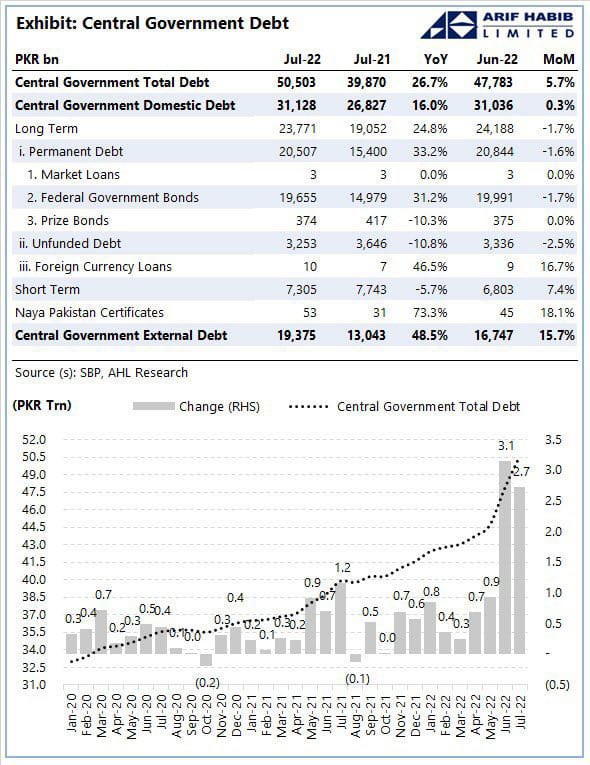
#Darnomics & the #DarPeg 🚨
A thread 🧵 —
There are two very clear scenarios in #Pakistan 🇵🇰 at the moment:
A thread 🧵 —
There are two very clear scenarios in #Pakistan 🇵🇰 at the moment:

Scenario 1 —
Finance Minister @MIshaqDar50 continues “managing” the country’s exchange rate. Once he’s gone (3-6 months), and a caretaker government comes in, PKR will shoot up (possibly overshoot) to previously unseen levels beyond 275 vs. USD.
Finance Minister @MIshaqDar50 continues “managing” the country’s exchange rate. Once he’s gone (3-6 months), and a caretaker government comes in, PKR will shoot up (possibly overshoot) to previously unseen levels beyond 275 vs. USD.
Scenario 2 —
Mr. Dar decides to let PKR find its true value based on market fundamentals driven by #Pakistan’s true (glaring 👀) macroeconomic realities. In this scenario, I foresee PKR depreciating to between 250-260 & stabilising within this range for the next 6 months.
Mr. Dar decides to let PKR find its true value based on market fundamentals driven by #Pakistan’s true (glaring 👀) macroeconomic realities. In this scenario, I foresee PKR depreciating to between 250-260 & stabilising within this range for the next 6 months.
Scenario 1 Advantages —
* Good optics for the ruling #PDM (@pmln_org & @MediaCellPPP) coalition
* Temporary respite in inevitable inflation 📈
* Good optics for the ruling #PDM (@pmln_org & @MediaCellPPP) coalition
* Temporary respite in inevitable inflation 📈
Scenario 1 Disadvantages —
* Exporters see real value of USD as significantly higher, delaying realisation of export proceeds
* Remitters (expats) only send essential remittances, whilst delaying non-essential inflows to a future date (〽️ trend visible in the last 4 months)
* Exporters see real value of USD as significantly higher, delaying realisation of export proceeds
* Remitters (expats) only send essential remittances, whilst delaying non-essential inflows to a future date (〽️ trend visible in the last 4 months)
* FDI investors delay investment plans (citing artificial PKR value) to avoid exchange losses
* Value of imports artificially lower (despite imports compression strategy), thus not fully leading to demand destruction for imports
* Massive potential devaluation around the corner
* Value of imports artificially lower (despite imports compression strategy), thus not fully leading to demand destruction for imports
* Massive potential devaluation around the corner
Scenario 2 Advantages —
* Exporters see PKR trading at its fair market value vs. USD. Therefore, no arbitrage or incentive for delaying realisation of export proceeds. Critical USD inflows into #Pakistan become orderly & timely
* Exporters see PKR trading at its fair market value vs. USD. Therefore, no arbitrage or incentive for delaying realisation of export proceeds. Critical USD inflows into #Pakistan become orderly & timely
* REER < 100 (optimal level = 94-96) —> exports competitive, countering headwinds from ongoing global economic slowdown
* Hundi / Hawala become non-competitive again (elimination of interbank vs. open market vs. unofficial market ER’s) resulting in higher official remittances
* Hundi / Hawala become non-competitive again (elimination of interbank vs. open market vs. unofficial market ER’s) resulting in higher official remittances
* Remitters send essential & non-essential remittances on-time, as potentially no advantage in delaying inflows since PKR is fairly valued
* Exaggerated potential exchange losses cease to remain a major risk / hurdle for FDI investors or a cause for investment plan delays
* Exaggerated potential exchange losses cease to remain a major risk / hurdle for FDI investors or a cause for investment plan delays
* Finally, imports become expensive, thus leading to further demand destruction in the wider economy (helped by already tightening disposable incomes in the country due to high inflation), thus lessening the pressure on #Pakistan’s crucial FX reserves —> conservation of reserves
Scenario 2 Disadvantages —
* Bad optics for the ruling #PDM (@pmln_org & @MediaCellPPP coalition) given how Mr. Dar has built up a reputation as the “Dollar Nemesis” over the last decade or so
* Bad optics for the ruling #PDM (@pmln_org & @MediaCellPPP coalition) given how Mr. Dar has built up a reputation as the “Dollar Nemesis” over the last decade or so
* Spike in inflation leading to an inevitable further tightening of monetary policy (interest rates) by #SBP until a softening in global commodity prices due to worldwide recession / slowdown causes inflation to reduce (6-12 months timeframe) & interest rate tightening to reverse
So what will Mr. Dar choose to do?
* Will he / should he continue with what he is doing today? If so, why?
* Or should he go with what the @IMFNews and a broad set of global financial market participants / macroeconomists are advising?
We don’t have too long to find out…
* Will he / should he continue with what he is doing today? If so, why?
* Or should he go with what the @IMFNews and a broad set of global financial market participants / macroeconomists are advising?
We don’t have too long to find out…
• • •
Missing some Tweet in this thread? You can try to
force a refresh
















